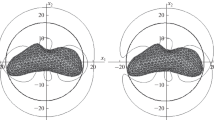Abstract
To develop a mathematical model of rotational motion of an artificial satellite about its center of mass under the action of various forces (magnetic, Lorentz, etc.) caused by the geomagnetic field, it is necessary to know the induction of the Earth's magnetic field (EMF) as a function of the radius vector of a given point in the near-Earth space. Because the EMF possesses a complex structure and the above-mentioned functional dependence is unavailable in explicit analytic form, a set of approximate models of the EMF should be used. The simplest such model—a right dipole (aligned with the axis of rotation)—does not enable one to reveal in detail the influence of diurnal EMF rotation on the rotational motion of a satellite. The next EMF approximation—an inclined magnetic dipole—does not suffer from the above-mentioned drawback. However, it is shown that not all corrections to the magnetic induction of the EMF of the same order of magnitude are taken into account in the course of transformation from the model of aligned dipole to the model of inclined dipole. So, to develop the EMF model accurately accounting for the absence of axial symmetry of the EMF with respect to the axis of diurnal rotation of the Earth, in general, the effect of the quadrupole component of the geomagnetic potential on the EMF induction (and, probably, even the components of higher orders) must be taken into consideration. By using the International Geomagnetic Reference Field IGRF-2000, the multipole models of the EMF, corresponding to quadrupole, octupole, and higher-order approximations, were constructed and studied in this work. The EMF potential is expressed in terms of its multipole tensors. As a result, projections of the induction and induction gradient of EMF in the center of mass of the satellite onto the axes of the orbital coordinate system can be written in convenient and concise form. The expressions for the first four multipole tensors through the known geomagnetic constants are found. A method for estimating the reliability of these models is put forward, and the regions of applicability of the quadrupole and octupole models are drawn on the plane of orbital parameters.
Similar content being viewed by others
REFERENCES
Tikhonov, A.A. and Petrov, K.G., Moment of Lorentz Forces Acting upon a Charged Satellite in the Earth's Magnetic Field: Part 1. The Strength of the Earth's Magnetic Field in Orbital Coordinate System, Vestn. S.-Peterburg Univ., Ser. 1, 1999, no. 1, pp. 92–100.
Mandea, M. et al., International Geomagnetic Reference Field-2000, Physics of the Earth and Planetary Interiors, 2000, vol. 120, pp. 39–42.
Sarychev, V.A. and Ovchinnikov, M.Yu., Magnetic Systems of Attitude Control for Earth's Artificial Satellites, Itogi Nauki Tekh., Ser: Issled. Kosm. Prostr., vol. 23, Moscow: VINITI, 1985.
Author information
Authors and Affiliations
Rights and permissions
About this article
Cite this article
Tikhonov, A.A., Petrov, K.G. Multipole Models of the Earth's Magnetic Field. Cosmic Research 40, 203–212 (2002). https://doi.org/10.1023/A:1015916718570
Issue Date:
DOI: https://doi.org/10.1023/A:1015916718570




